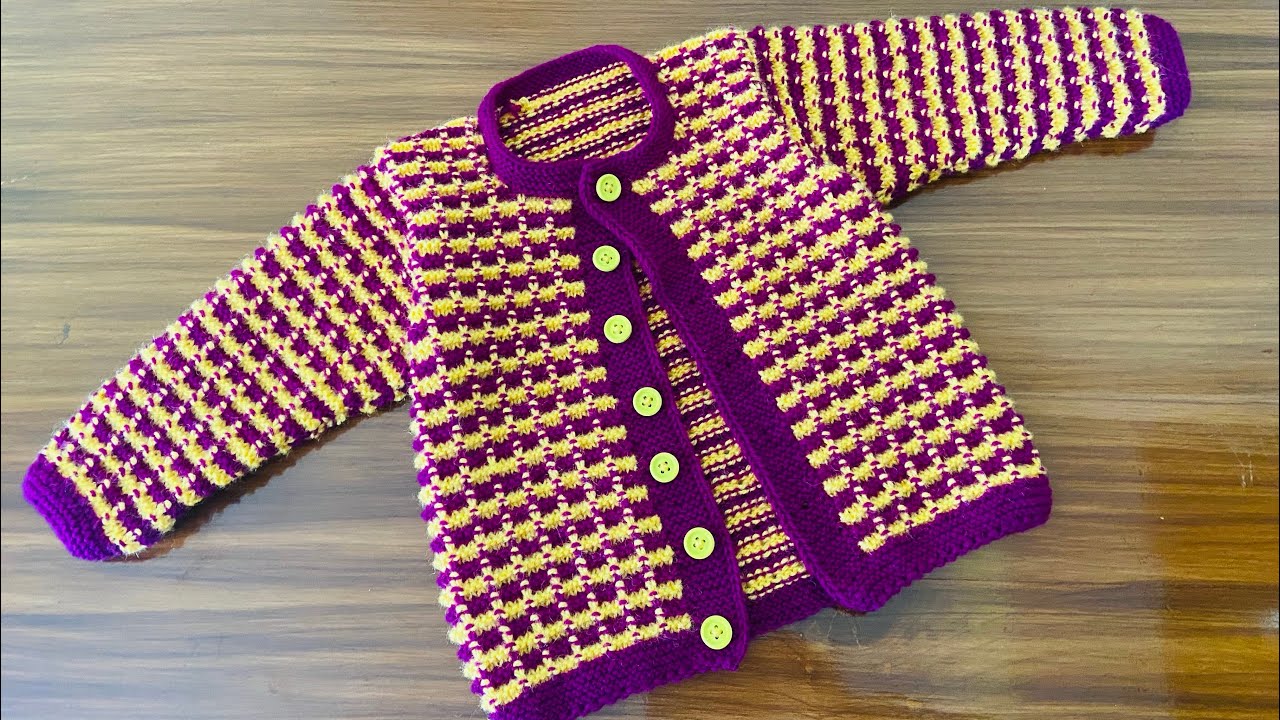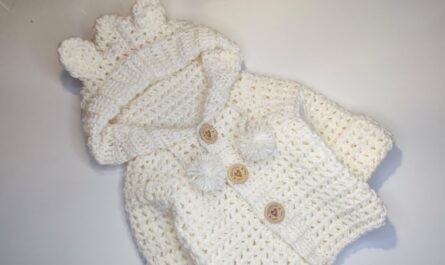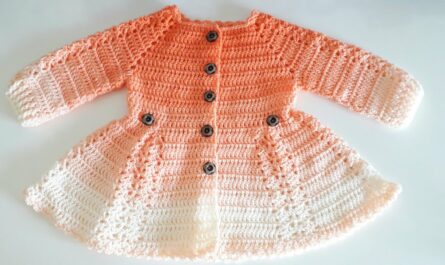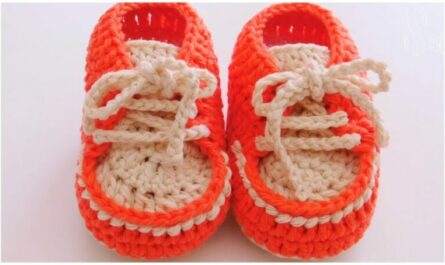A baby sweater is a beloved handmade gift, and adding a second color introduces a whole new dimension of design possibilities. Beyond just providing warmth, a two-color sweater can reflect personality, coordinate with nursery themes, or simply offer a vibrant touch. The beauty of two-color knitting for baby garments lies in its ability to transform simple shapes into captivating designs without requiring overly complex techniques.
This guide will walk you through the essential steps and inspiring ideas for creating your very own two-color baby sweater design, ensuring it’s both adorable for the little one and enjoyable for you to knit.
Foundation First: Essential Considerations for Any Baby Sweater
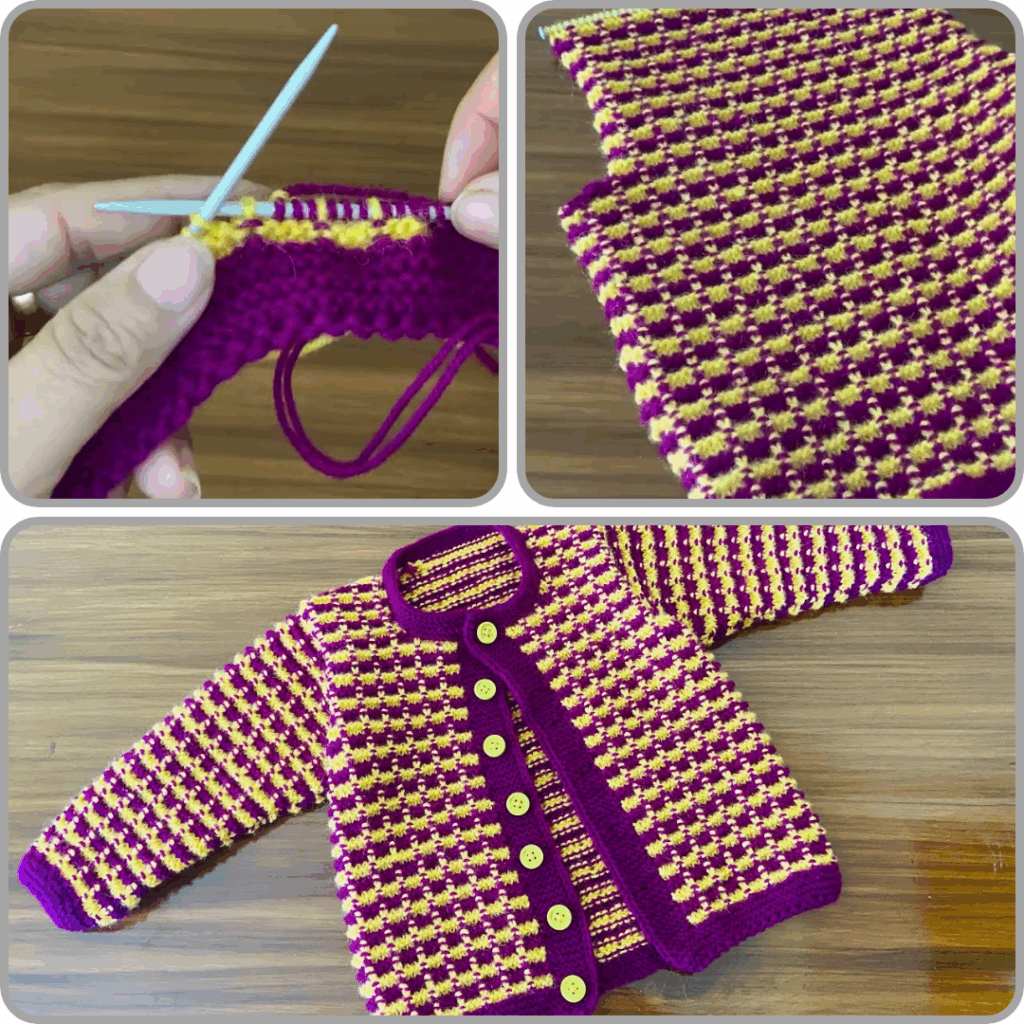
Before diving into color specifics, let’s recap the foundational elements crucial for any baby garment:
- Yarn Choice is Paramount:
- Fiber Content: Prioritize softness and washability. Superwash Merino Wool is often the gold standard due to its incredible softness, warmth, breathability, and machine-washable properties. Other great options include soft cotton, bamboo, or high-quality, baby-specific acrylics or blends (e.g., wool/cotton, acrylic/nylon). Avoid anything scratchy or prone to felting easily.
- Yarn Weight: This affects gauge and how quickly your project knits up.
- DK (Double Knitting) / Sport weight: Very popular, offers a good balance of warmth and reasonable knitting time.
- Worsted weight: Knits up faster, creating a cozier, slightly thicker fabric.
- Fingering/4-ply: Best for delicate, lightweight garments or very intricate colorwork, but will take longer to knit.
- Color Selection: Choose two colors that complement each other well. Think about:
- Contrast: High contrast (e.g., white and navy, bright pink and grey) makes patterns pop. Low contrast (e.g., two shades of blue) creates a more subtle effect.
- Hue: Are they analogous (next to each other on the color wheel, like blue and green)? Complementary (opposite, like blue and orange)? Or classic neutrals?
- Baby-Friendly: Bright, cheerful colors are popular, but soft pastels or muted tones can be equally charming.
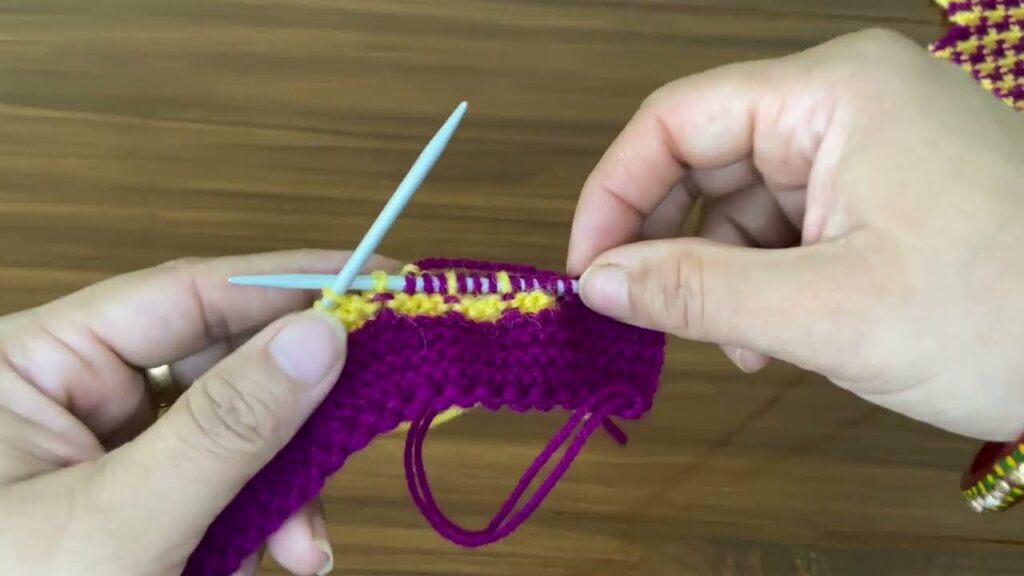
- Sizing and Age:
- Baby sizes are often given in age ranges (e.g., Newborn, 0-3 months, 3-6 months, 6-12 months).
- Always refer to a reliable baby size chart for chest circumference, length, and sleeve length.
- Design with a little positive ease (1-2 inches larger than the baby’s actual chest) to allow for comfortable layering and room to grow.
- Gauge Swatch (Non-Negotiable for Garments!):
- Knit a 4×4 inch (10×10 cm) swatch in your chosen yarn and stitch pattern (and colors, if it’s a colorwork stitch).
- Wash and block your swatch as you would the finished garment. This is crucial for wools that might bloom or relax.
- Measure your stitches and rows per inch accurately. This is the only way to ensure your sweater will be the correct size. Adjust needle size if your gauge is off.
- Construction Method:
- Top-Down Raglan (Seamless): Very popular for baby sweaters as it’s often seamless (fewer seams to bother baby’s skin), allows for easy length customization, and is simple to try on as you knit.
- Bottom-Up & Seamed: Traditional method where pieces (front, back, sleeves) are knit flat and then seamed together. Good for showcasing certain stitch patterns.
- Yoke Construction: Can be round or square, and is often the main canvas for colorwork in top-down designs.
Two-Color Design Techniques for Baby Sweaters:
The beauty of two-color knitting is its versatility. Here are some easy-to-intermediate techniques perfect for baby sweaters:
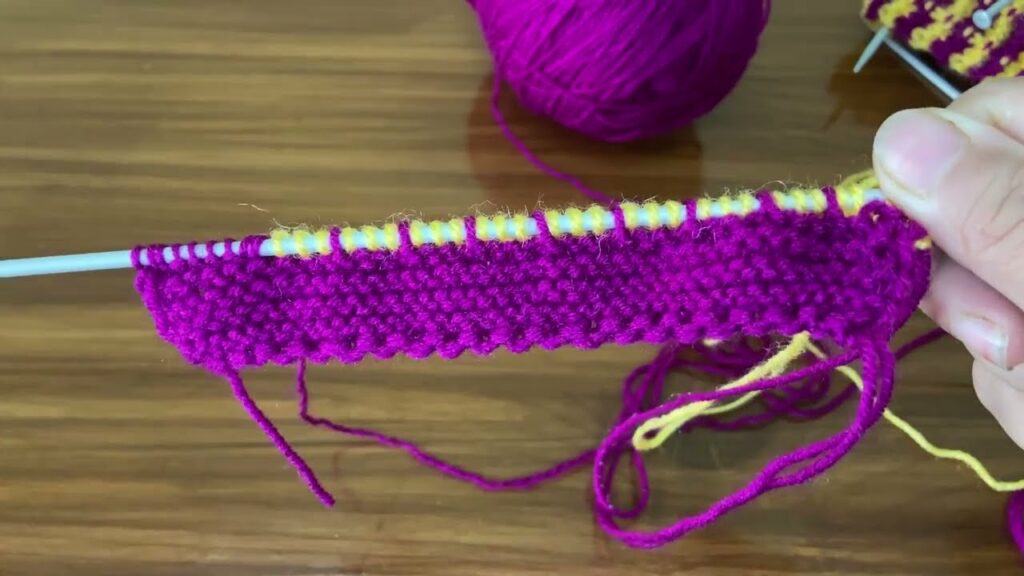
1. Horizontal Stripes: The Timeless Classic
- How to Do It: The simplest form of colorwork. You knit a set number of rows in one color, then switch to the second color for another set of rows, and repeat.
- Design Ideas:
- Even Stripes: Equal number of rows in each color (e.g., 4 rows of Color A, 4 rows of Color B).
- Uneven Stripes: Vary the width of the stripes (e.g., 2 rows of Color A, 6 rows of Color B, 2 rows of Color A, 10 rows of Color B). This creates visual interest.
- Ombre/Gradient Effect: Use two colors and introduce a third that’s a blend or transition color for a subtle fade.
- Striped Yoke/Cuffs/Hem: Use stripes only on specific sections like the yoke, sleeves, or bottom hem, leaving the main body solid.
- Tips:
- Carrying Yarn: If stripes are narrow, you can carry the unused color loosely up the side of your work to avoid cutting and rejoining. This works best when knitting in the round.
- Neat Color Changes: To avoid a jog where colors meet in the round, slip the first stitch of the new color and/or knit into the stitch below. Many tutorials explain this.
- Gauge: Ensure your tension remains consistent when switching colors.
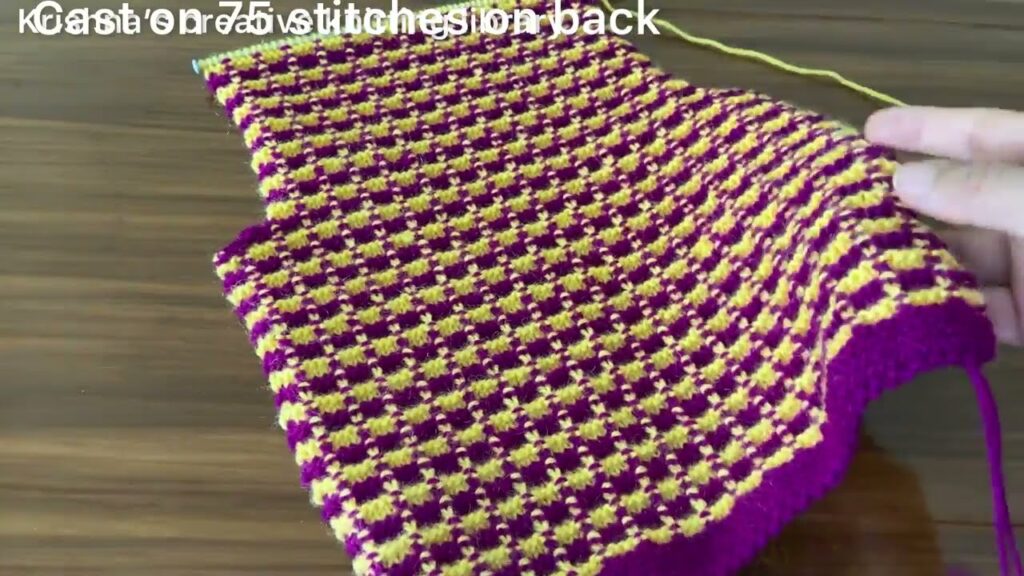
2. Color Blocking: Bold & Modern
- How to Do It: Knit entire sections of the sweater in one color, then switch to the other color for a large, distinct section.
- Design Ideas:
- Half & Half: Knit the bottom half of the sweater in one color, and the top half (including the yoke/sleeves) in the second color.
- Contrast Yoke: Knit the body and sleeves in one color, and the entire yoke in a contrasting color. This is a very popular and striking design.
- Contrast Sleeves/Pockets: Knit the main body in one color, and the sleeves or even simple patch pockets in the second color.
- Asymmetrical Blocks: Create vertical blocks by knitting different panels in different colors and seaming them, or by using intarsia.
- Tips:
- Seamless Joins: For color blocking in the round, aim for a clean color change as mentioned for stripes.
- Intarsia (for vertical blocks): If you want distinct vertical blocks without seams, you’ll need to learn intarsia. This involves using separate balls of yarn for each color block, twisting them where they meet to avoid holes. While a bit more advanced than stripes, simple intarsia shapes (like a large circle or heart) can be very effective and worth learning.
3. Simple Patterned Colorwork (Stranded or Slip Stitch):
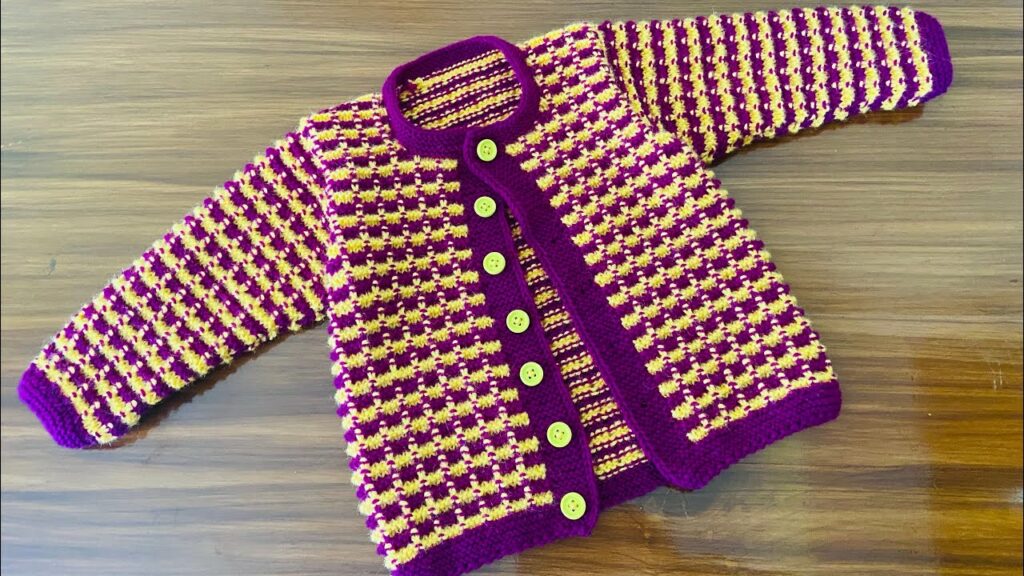
- How to Do It:
- Stranded Colorwork (Fair Isle inspired): You knit with two colors in the same row, carrying the unused color across the back of the work. For baby sweaters, stick to very simple motifs with short “floats” (the carried yarn) to avoid snagging.
- Slip Stitch Colorwork: You use only one color per row, but you slip stitches from the previous row to create a textured pattern using the underlying color. This is easier than stranded knitting as you only manage one yarn at a time.
- Design Ideas:
- Simple Motifs: Tiny stars, hearts, dots, or small geometric patterns repeated across the yoke or body.
- Checkerboard: Alternating squares of knit/purl stitches in two colors.
- Polka Dots: Simple large or small dots spread out.
- Contrast Ribbing/Cuffs/Hems: Use a contrasting color for all ribbed sections to frame the main body.
- Tips:
- Tension: Keep floats loose in stranded knitting to prevent the fabric from puckering.
- Chart Reading: Patterned colorwork usually involves reading a knitting chart.
- Stitch Definition: Choose yarns that show off the pattern well.
4. Embellishments & Finishing Touches:
- Contrast Edging: Use your second color for a crocheted edging around the neckline, cuffs, or hem for a delicate touch.
- Buttons: Select buttons that complement both colors in your design.
- Embroidery: After knitting, use your second color (or even a third) to embroider small details like eyes, noses, or simple outlines onto a solid block of color.
- I-Cord: Create an I-cord in one color and sew it onto the sweater in a decorative pattern or use it as a tie closure.
A Basic Design Process for Your Two-Color Sweater:

- Choose Your Construction: Decide if you want top-down seamless or seamed pieces. For beginners, top-down raglan is often recommended.
- Select Your Yarn & Colors: Pick your two beautiful, baby-friendly yarns.
- Determine Size & Gauge: Swatch, swatch, swatch! And measure your gauge carefully.
- Sketch Your Design:
- Draw the basic sweater shape.
- Decide where the two colors will be placed: all stripes? Just a contrasting yoke? Color-blocked body?
- If using patterns, roughly sketch them onto your drawing.
- Calculate Stitches: Using your gauge, calculate your cast-on stitches and the number of increases/decreases needed for your chosen size and design elements.
- Write It Down (Even for Yourself): Note your row counts for stripes, stitch counts for different sections, and any specific color changes. This will keep you organized.
- Knit Away! Enjoy the process of watching your two colors come to life.
Tips for Success with Two-Color Knitting:
- Yarn Management: Keep your yarn balls untangled, especially when working with two colors simultaneously. Yarn bowls or separate bags can help.
- Tension Consistency: Try to maintain even tension across both colors. Sometimes, one color might feel slightly tighter or looser.
- Blocking is Your Friend: Blocking is essential for colorwork. It helps to even out stitches, relaxes the fabric, and makes patterns lie flat and even.
- Check for Baby Safety: Ensure all seams are flat, buttons are securely sewn, and there are no loose threads or embellishments that could pose a choking hazard.
Video Tutorial :
Designing and knitting a two-color baby sweater is a joyful endeavor. By combining thoughtful yarn choices with engaging yet manageable colorwork techniques, you’ll create a unique and cherished garment that will wrap a little one in warmth and handmade love.
